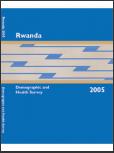Datasource:
Demographic and Health Survey (DHS)
Period:
February, 2005 to July, 2005
In the context of its desire to obtain a database designed to provide reliable indicators to monitor and assess the implementation of the country’s sector programs and policies, the Poverty Reduction Strategy, Vision 2020 and the commitments it has undertaken at the international level, in particular the Millennium Development Goals, the Government of Rwanda has just completed the Third Demographic and Health Survey (EDSR-III 2005).
EDSR-III follows the datasources that were successfully conducted in 1992 and 2000, and is part of a broad, worldwide program of socio-demographic and health Surveys conducted in developing countries since the mid-1980’s. In addition to the indicators on fertility, family planning, and maternal and child health which the Survey normally provides, the main innovation of EDSR-III was the integration of a datasource module on the seroprevalence of HIV and anemia as well as a module on domestic violence. As such, for the first time, the datasource allowed us to determine the prevalence of HIV at the national level.
Microdata for Demographic and Health Survey (2005)
Microdata for Demographic and Health Survey (2005)
Publications
Rwanda Demographic and Health Survey Report (DHS 2005)
This report presents the findings of the 2005 Rwanda Demographic and Health Survey (RDHS-III), carried out from February to July 2005 by the Direction de la Statistique (renamed Institut National de la Statistique du Rwanda in September 2005).
Demographic and Health Survey (DHS 2005)
A total of 10,644 households were selected in the sample for the third Rwandan Demographic and Health survey (RDHS-III), and 10,307 of these were contacted at the time of the survey. The survey teams were able to interview individuals in 10,272 households, for a response rate of nearly 100 percent. In the 10,272 households surveyed, 11,539 women between 15 and 49 years of age were considered eligible for individual interviews and 11,321 were successfully interviewed

![[title]](https://statistics.gov.rw/sites/default/files/styles/pub_small_112x150_/public/publications/5ea154d0-24c9-4780-86a6-1e23256759b7/coverdhs2005.jpg?itok=A6VFb6hE)
